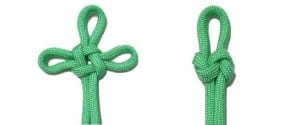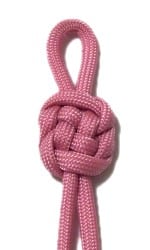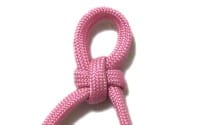Knots are not only a simple decoration in Chinese culture but are a very important form of art with a long history and rich symbolism. Each kind of Chinese knot has its own special meaning, and not many have known that the knots were originally the Ancient Chinese way of recording history and information before the creation of today’s Chinese characters.
What Is a Chinese Knot?
A Chinese knot is a single length of rope (or cord) that is tied and weave into many different shapes. The shapes of the Chinese knots are mainly symmetrical and double-layered, characterized by two cords “entering” the knot from the top and two cords leaving the bottom. The bottom cords are commonly decorated with bells, gold decorations, and thinner cords, among others.
As discussed, Chinese knotting ((Chinese: 中国结; pinyin: Zhōngguó jié) is a traditional Chinese folk art that has been around for a very long time, with evidence showing that they have been around as far back as 100,000 years ago.
Over the long history of Chinese Knotting, there have been various shapes of knots with varying complexities. All the different kinds of knots are named, either after their shapes or the symbolic meanings of the knot.
Chinese knots are mainly made with red cord, although they can vary in color. As we know, red is very important and the most popular color in China, symbolizing fortune and wealth. In modern China, the knots are mainly used as house decorations (especially during festive occasions), used as decorations and buttons in traditional Chinese fashion, and are given as presents on special occasions.
It is believed that the Ancient Chinese have originally made knots as a method to record and exchange information. There is a pretty recent discovery of bone tools that were used for tying and untying of knots that are believed to be at least 100,000 years-old. It is believed that the shape of a knot would describe the nature of the recorded event, while the size of the knot would signify the importance of the event.
However, the more factual evidence of Chinese knotting was recorded on bronze vessels from the Warring States Period, circa 403-221 BCE, and also from archaeology and literature evidence from the same period.
Evidence from this era suggested that the knots had a specific function of recording events and to pass judgments in the court of law. There is also literature evidence suggesting that the knots are used in agreements between governments.
The knot also has a strong tie to Buddhism, as we can see in Buddhist carvings of the Northern Dynasties period (circa 317-581 CE). The famous Pan Chang knot or mystic knot, for example, is known as one of the eight symbols of Buddhism in China.
There are also silk paintings of the Western Han period (206 BCE-9 CE) that illustrates the usage of knots.
However, the development of Chinese knotting as a distinct decorative folk art can be traced a little bit further back, starting from the Spring and Autumn periods (771-476 BCE) before the Warring States Period. Simple ribbon knots have been used on Chinese clothing from this period, which influenced the Lao Zi (络子) culture in ancient China, the tradition of tying a silk or cotton ribbon knot at the waist.
The Lao Zi tradition and decorative knots in clothing continued and evolved for thousands of years. There is evidence from the times of the Ming Dynasty (1368-1644 CE) that showed the knots as a clothing decoration.
Separately, the use of knots in household decoration has also evolved. The Pan Chang knot, for example, started gaining popularity during the Song and Yuan Dynasties (930-1368 CE).
It was during the Qing Dynasty (1644-1911) when Chinese Knotting finally became a distinct art form in Chinese culture, which stays until today.
Types of Chinese Knots
Although there are thousands of different types of Chinese knots, there are only ten types of basic Chinese knots and more complex knots are constructed from either combining these basic knots or repeating the patterns. They are:
1. Cloverleaf knot

The cloverleaf knot is the most basic and the most popular knot design used in Chinese knotting, often used as the basis for more complex knots. Similar to the plant it’s based on (clover, especially four-leaf clover), this knot symbolizes fortune and good luck. The traditional form uses 3 loops (3 flower shapes) but the 4 loops version is also pretty popular.
2. Chinese button knot

Quite similar to the western diamond (knife lanyard) knot, but the lanyard loop is much shortened, typically tied to the knot itself. In Chinese clothing, this type of knot is frequently sewn to make the closures/buttons, hence the name. The traditional button knot has five loops.
3. Round brocade knot

The round brocade knot symbolizes good fortune, wholesomeness/completeness, and balance, and is shaped like a five-petal flower. This is why it is also often called the Chinese Flower Knot.
4. Double coin knot

Widely believed to be the oldest Chinese knot in existence, and the pattern resembles interwoven coins that symbolize the cycle of life. Often used as a starting form for other knot shapes.
5. Double connection knot

Similar to the Western linked-overhand knot, and it’s very popular in China for hanging decorations/items from the ceiling or the wall, and also to secure the hooks in earrings or jewelry.
6. Sauvastika knot

A simple but very important knot in Chinese knotting, symbolizing true love, based more on the Japanese’s agemaki pattern that is commonly found in Samurai Armor rather than the actual sauvastika (swastika) symbol that is used in both Buddhism and Hinduism.
7. Plafond knot

Shaped like a spiral with a rectangular border, symbolizing the dome-like central sections of Chinese temples’ ceilings, hence the name “plafond” which means “ornate ceiling”. Typically involves three rectangular sections, three deep and three across.
8. Cross knot

Arguably the easiest knot to make, and very popular in Chinese knotting to make a stable loop for hanging or closure.
9. Square knot/good luck knot

A variation of the cross knot, symbolizes good fortune, so often called good luck knot.
10. Pan Chang knot

The most popular Chinese knot, synonymous with Chinese knotting itself, consisting of 8 loops and 8 “ears” and is a very important symbol in Buddhism. Also known as the “mystic” knot, it is believed to give good fortune to those who wear it.
Stay in Touch
 Join our newsletter by using the forms on this website or click here!
Join our newsletter by using the forms on this website or click here! Follow us on Google News
Follow us on Google News Follow us on Facebook
Follow us on Facebook
Featured Image from Wikimedia Commons (CC BY-SA 3.0)





